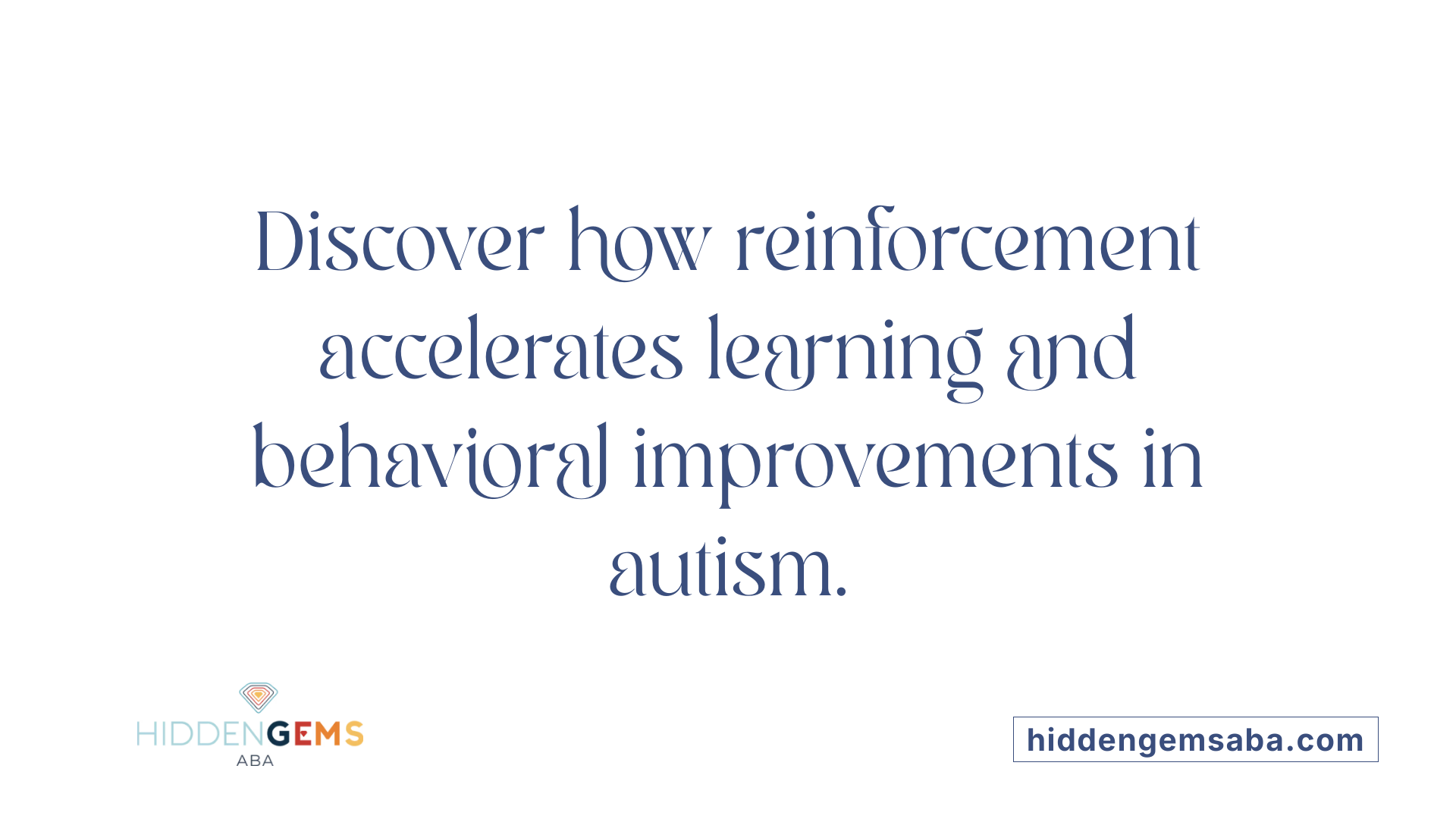Understanding Reinforcement in ABA for Autism
Reinforcement forms the cornerstone of applied behavior analysis (ABA) therapy, especially in the context of autism. It is a scientifically validated approach grounded in operant conditioning principles, which utilize targeted consequences to shape and modify behavior. By carefully applying reinforcement strategies, therapists and caregivers can effectively promote skill development, reduce problematic behaviors, and foster independence in individuals with autism.
Fundamental Concepts of Reinforcement in ABA
What is reinforcement in ABA therapy for autism?
Reinforcement in ABA therapy for autism is rooted in the science of operant conditioning, a learning process established by psychologist B.F. Skinner. It involves applying consequences to behaviors to increase or decrease their occurrence. In practice, reinforcement means providing a stimulus—such as praise, a toy, or an activity—immediately following a desired behavior to make it more likely to happen again.
There are two main types of reinforcement used in ABA: positive and negative. Positive reinforcement involves adding a rewarding stimulus — for example, giving a child a high-five after they correctly identify a picture. Negative reinforcement involves removing an unpleasant stimulus, like stopping a loud noise when a child begins to sit quietly. The goal of these strategies is to encourage the development of useful skills such as communication, social interaction, and self-help.
Therapists choose reinforcers based on individual preferences, ensuring they are motivating for each person. These can include tangible rewards, social praise, or preferred activities. By systematically applying reinforcement techniques like differential reinforcement—where specific behaviors are reinforced while others are not—therapists promote adaptive behaviors and diminish problematic ones. This approach plays a crucial role in helping individuals with autism acquire new skills and improve overall functioning.
Types of Reinforcement in ABA and Their Applications

What are the different types of reinforcement used in ABA therapy?
In Applied Behavior Analysis (ABA), reinforcement techniques are essential for shaping and encouraging desired behaviors. The primary type is positive reinforcement, which involves adding a motivating stimulus, such as praise, tokens, or preferred items, immediately after a behavior to increase its likelihood of recurrence.
Negative reinforcement, on the other hand, involves removing an unpleasant stimulus following a behavior, which also encourages that behavior to happen again. For example, stopping loud noise when a child initiates communication.
Besides these main types, behavioral specialists frequently employ differential reinforcement strategies. Differential reinforcement includes:
| Type | Description | Example |
|---|---|---|
| DRA (Differential Reinforcement of Alternative Behavior) | Reinforcing a behavior that is an acceptable alternative to undesirable behaviors | Reinforcing eye contact instead of tantrums |
| DRI (Differential Reinforcement of Incompatible Behavior) | Reinforcing a behavior incompatible with the problem behavior | Reinforcing sitting calmly instead of pacing |
| DRO (Differential Reinforcement of Other Behavior) | Reinforcing the absence of problem behaviors within a time interval | Reinforcing no self-injury for a set period |
| DRL (Differential Reinforcement of Low Rates) | Reinforcing when a behavior occurs less frequently | Reinforcing fewer tantrums per day |
Reinforcers can be categorized into several types based on their nature:
- Primary Reinforcers: Naturally rewarding stimuli such as food or water.
- Social Reinforcers: Social responses like praise, smiles, or high-fives.
- Tangible Reinforcers: Items like toys, stickers, or prizes.
- Activity Reinforcers: Preferred activities or privileges like playtime or extra recess.
Implementing these reinforcement strategies effectively requires selecting personalized reinforcers that motivate the individual and delivering them immediately after the desired behavior. This approach fosters learning and helps reduce problematic behaviors while promoting skills such as communication, social interaction, and daily living skills. Regular monitoring and adjustment of reinforcement schedules enhance their effectiveness, making them a versatile and powerful tool in ABA therapy for autism.
Implementing Reinforcement Effectively in ABA Therapy
How can reinforcement be effectively implemented in ABA therapy?
Effective reinforcement hinges on selecting rewards that are personally motivating and delivered at the right times. In ABA, therapists identify what motivates each individual, which can include tangible objects, social praise, or activities. The chosen reinforcers should be immediate and contingent on the targeted behavior, meaning they follow closely after the behavior occurs.
Structured reinforcement plans, such as token systems or verbal praise, are essential. These plans help create consistency and clarity, making it easier for children to associate their actions with positive outcomes. For example, giving a child a token immediately after they make eye contact can reinforce this social skill.
Fading reinforcement gradually is a critical component to promote independence. As behaviors become more ingrained, reinforcement schedules can be thinned out—moving from continuous reinforcement to partial schedules—so the individual can maintain skills without constant rewards.
Monitoring progress closely allows therapists and caregivers to adjust strategies as needed. If a behavior is not increasing, the reinforcer might need to change or the timing might need improvement.
Alignment with the child's preferences, the behavior's function, and their developmental level ensures safety and ethical practice. Consistent reinforcement across different settings and team members, including caregivers, is key for generalization and long-term success.
Ultimately, thoughtful implementation of reinforcement supports meaningful behavior change, skill development, and increased independence.
Benefits of Reinforcement in Autism Interventions

What are the benefits of using reinforcement in ABA therapy for individuals with autism?
Reinforcement plays a vital role in ABA (Applied Behavior Analysis) therapy, offering a wide array of advantages tailored to support autistic individuals. One of the primary benefits is enhanced skill development. By pairing desired behaviors with rewards, such as praise, tokens, or preferred activities, children are motivated to learn new communication, social, and self-help skills more effectively.
Another notable benefit is the reduction of challenging behaviors. Reinforcement strategies help identify triggers for problematic actions like tantrums or self-injury, and by rewarding more adaptive behaviors, these behaviors become more frequent while undesirable ones decrease.
Reinforcement also boosts motivation and confidence. When children see their efforts are acknowledged positively, they feel more encouraged and confident to engage in learning and social interactions. This increased motivation fosters a more active participation in therapy sessions and daily routines.
Furthermore, reinforcement supports the generalization of skills across different environments, such as from a therapy setting to home or school. Consistent reinforcement ensures new skills are not only learned but also applied widely, making progress more sustainable.
Finally, the long-term benefits include meaningful developmental gains that can last beyond the therapy period. Reinforcement helps establish foundational behaviors that contribute to greater independence and better quality of life.
Overall, reinforcement is a core element in ABA therapy that facilitates learning, reduces challenging behaviors, and promotes lasting development, thereby significantly improving intervention outcomes for individuals with autism.
| Aspect | Description | Additional Note |
|---|---|---|
| Skill Development | Motivates acquisition of communication, social, and daily skills | Reinforcers are individualized and motivating |
| Behavior Reduction | Decreases problematic behaviors by rewarding appropriate responses | Identifies triggers and encourages alternative behaviors |
| Motivation & Confidence | Builds self-esteem and enthusiasm for learning | Reinforcement makes learning engaging |
| Skill Generalization | Encourages applying skills across various settings | Ensures progress is not context-dependent |
| Long-term Gains | Supports sustained developmental progress | Contributes to independence and overall quality of life |
This comprehensive approach underlines why reinforcement remains a cornerstone of effective autism interventions.
Best Practices for Applying Reinforcement in ABA

What are best practices for applying reinforcement within ABA therapy?
Effective reinforcement strategies are central to successful ABA therapy. One of the most important principles is individualizing reinforcers. Each person has unique preferences, so therapists should identify what motivates the individual—be it toys, praise, activities, or social interactions—and use these as rewards.
When implementing reinforcement, timing is crucial. Reinforcers should be delivered immediately after the desired behavior occurs. This immediate response helps strengthen the association between behavior and reward, promoting learning and increasing the likelihood of recurrence.
Using a variety of reinforcers helps maintain motivation and engagement. These can include tangible items like toys or snacks, social rewards such as verbal praise or high-fives, and activities the individual enjoys. Incorporating different types of rewards also prevents satiation and keeps the reinforcement process stimulating.
To foster independence and intrinsic motivation, therapists gradually fade reinforcement over time. This involves reducing the frequency or intensity of rewards, encouraging the individual to perform behaviors without constant external reinforcement while still maintaining desired behaviors.
Another essential practice is the use of reinforcement schedules, such as fixed or variable ratios. For example, a fixed schedule provides reinforcement after a set number of responses, while a variable schedule delivers reinforcement unpredictably. These schedules help sustain behaviors over time and prevent extinction.
Finally, reinforcement should be integrated within a comprehensive treatment plan that includes other ABA strategies like prompting, shaping, and differential reinforcement techniques (DRA, DRI, DRO, DRL). Continuous monitoring and data collection ensure that reinforcement remains effective, allowing adjustments as the individual develops new skills or shows changing preferences.
Applying these best practices ensures that reinforcement effectively promotes desirable behaviors, skill development, and overall progress in ABA therapy, especially for children with autism.
Additional Strategies and Ethical Considerations

How can reinforcement be effectively implemented in ABA therapy?
Effective reinforcement in ABA therapy involves a thoughtful, individualized approach. Therapists identify what motivates each person, whether it's praise, tokens, or preferred activities, and ensure reinforcement is immediate and consistent. Using structured methods like token economies or social praise encourages desired behaviors to form habits.
A critical aspect is gradually fading reinforcement through schedule thinning, where the frequency of reinforcement decreases as behaviors become more ingrained. This timing fosters independence and reduces reliance on external rewards.
Monitoring progress is essential; therapists regularly assess whether behaviors are increasing and adapt reinforcement strategies accordingly. Reinforcers should match the individual’s preferences and be appropriate to their developmental level.
Safety and ethical standards are paramount—reinforcement should promote positive development without causing discomfort or exploitation. Consistent application across various environments and involvement of caregivers helps reinforce behaviors outside therapy, ensuring lasting change.
Overall, effective implementation combines careful plan design, ongoing assessment, and flexible adjustments to support meaningful behavioral improvements.
Summary and Future Directions in Reinforcement Strategies

What are the benefits of using reinforcement in ABA therapy for individuals with autism?
Using reinforcement in ABA therapy offers numerous benefits for individuals with autism. It enhances learning and skill acquisition by motivating children through positive feedback, such as praise or rewards, which helps them develop communication, social, and daily living skills. Reinforcement strategies also reduce problematic behaviors by identifying triggers and rewarding alternative, appropriate behaviors, leading to improved behavior management. Additionally, reinforcement promotes generalization of skills across different settings, supports independence, and fosters lasting developmental gains. Overall, reinforcement is a core component that drives effective, individualized intervention outcomes in ABA therapy.
How is reinforcement evolving, and what are current trends in ABA?
Emerging trends in reinforcement strategies center around personalization and technological integration. Digital tools and apps now enable real-time data collection and immediate feedback, making reinforcement more timely and engaging. Furthermore, innovations include the development of more diverse and motivating reinforcers tailored to individual preferences, increasing the effectiveness of interventions. Another trend involves using systems like token economies that can be easily adapted for home and school settings, promoting consistency and generalization. These advances help practitioners customize reinforcement plans more precisely, improving outcomes for individuals with autism.
Why is continuous assessment and adaptation crucial in reinforcement strategies?
Continuous assessment allows behavior analysts to monitor progress, identify which reinforcers are most effective, and detect any decline in desired behaviors. Adapting reinforcement protocols ensures that interventions remain aligned with the individual's evolving needs and preferences. This ongoing process prevents plateauing, maintains motivation, and maximizes learning efficiency. Overall, flexibility in reinforcement strategies ensures sustained success and facilitates lifelong skill development.
| Aspect | Current Practice | Future Outlook | Additional Notes |
|---|---|---|---|
| Personalization | Tailoring reinforcers to individual interests | Using AI and data analytics for precise matching | Enhances motivation and engagement |
| Technological Integration | Apps for tracking and delivering reinforcement | Increased use of virtual reality and gamified systems | Expands accessibility and immediate feedback |
| Reinforcement Schedules | Fixed and variable schedules to maintain behaviors | Adaptive schedules based on learner progress | Supports skill maintenance and generalization |
| Types of Reinforcers | Social, tangible, activity reinforcers | Novel reinforcers via digital platforms | Broader options align with individual preferences |
Reinforcement remains fundamental to ABA and autism intervention. As innovations continue, strategies will become more personalized, efficient, and engaging, ensuring better outcomes for individuals across their development journey.
Final Thoughts on Reinforcement in Autism Therapy
Reinforcement remains a fundamental element of ABA therapy for autism, driving meaningful behavior change and skill development. Through personalized, ethically applied, and strategically delivered reinforcement methods—such as positive reinforcement and differential reinforcement—therapists and caregivers can effectively promote adaptive behaviors while reducing challenging ones. Ongoing research and technological advances continue to refine these techniques, ensuring that interventions are more effective, engaging, and tailored to individual needs. Emphasizing consistent implementation, caregiver training, and progress monitoring will facilitate sustained improvements and long-term success in supporting individuals with autism.
References
- What is Differential Reinforcement? Exploring its Applications
- The Power of Positive Reinforcement in ABA
- What is Reinforcement?
- Positive and Negative Reinforcement in Autism Therapy
- The Power of Positive Reinforcement in ABA Therapy
- Understanding Positive Reinforcement in ABA Therapy | PMT
- Understanding Reinforcement in ABA: Key Principles and ...






